Exploring the Truth About AI Music: Myths & Facts
Gary WhittakerAI Music: Ethical Practices and Copyright Considerations for Creators
The rise of AI in music creation has opened doors for artists, hobbyists, and content creators to produce high-quality tracks with minimal resources. Yet, this groundbreaking technology comes with challenges, especially concerning ethical practices and copyright considerations. As creators explore AI tools like Suno AI, understanding these responsibilities is crucial for fostering creativity while respecting others' intellectual property.
The Role of AI in Music Creation
AI music tools enable creators to craft melodies, lyrics, and full compositions with just a few prompts. However, it’s essential to realize that while these tools provide unparalleled convenience, they operate by leveraging large datasets, often trained on existing works. This raises ethical questions about originality and attribution.
AI-generated music is a game-changer, but it also demands thoughtful use. By integrating AI into your creative process, you gain access to a unique collaborator—but the responsibility to use it ethically lies with you.
Ethical Practices for AI Music Creators
1. Transparency in Labeling AI Creations
Always be upfront about using AI in your music. Labelling your tracks as “AI-assisted” or “AI-generated” fosters trust with your audience and ensures transparency in the creative process. It also helps distinguish your work from fully human-created compositions, preserving the integrity of both forms of art.
2. Respect Copyrighted Material
AI models are trained on vast datasets, some of which may include copyrighted content. As a creator, avoid directly replicating melodies, lyrics, or patterns from copyrighted songs. Tools like Suno AI are designed to generate original outputs, but it's your responsibility to review and ensure your work doesn’t unintentionally infringe on existing copyrights.
3. Attribute Collaborative Contributions
If your creation blends AI-generated elements with other contributors’ work—such as human vocalists or instrumentalists—credit everyone involved. Clear attribution is not only ethical but also builds stronger creative relationships.
4. Avoid Plagiarism
Plagiarism isn’t just about copying someone else’s work word-for-word or note-for-note—it includes taking credit for anything not originally yours. Regularly check your work against databases or use AI plagiarism detection tools to ensure your output remains unique.
Legal Considerations and Copyright Basics
Navigating copyright law can feel intimidating, especially for new creators. Here are key points to keep in mind:
-
Who Owns AI-Generated Music? Ownership laws around AI-generated works are still evolving. In most cases, the person or entity using the AI tool holds the rights to the output. However, this can vary by jurisdiction, so research local copyright laws.
-
Originality and Registration For your music to be copyrighted, it must meet originality standards. AI-generated works often require significant human input to qualify. You can enhance originality by refining lyrics, adjusting melodies, or adding personal artistic elements.
-
Public Domain and Licensing When incorporating AI into your creations, consider using public domain sounds or licensed samples. This adds a layer of protection while enriching your music with diverse influences.
-
Document Your Process Keep a record of your prompts, edits, and other contributions. This documentation can serve as proof of originality if questions of authorship arise.
Practical Recommendations for Getting Started
1. Develop Strong Prompts
The quality of your output heavily depends on the prompts you provide. Specify genre, mood, tempo, and instrumentation to guide AI toward creating music aligned with your vision. For example:
- “Generate an upbeat synth-pop track with a catchy melody, emphasizing uplifting lyrics about resilience.”
2. Iterate and Refine
Rarely is the first attempt perfect. Use the editing capabilities of tools like Suno AI to refine the initial output. Rework specific sections—like verses or bridges—and add your unique touch to elevate the track.
3. Learn the Basics of Copyright
Take time to understand copyright laws specific to your region. This knowledge will safeguard your work and help you navigate any legal complexities.
4. Engage with Your Audience
Share your journey transparently. Post snippets of your process or finished tracks on social media, inviting feedback and building connections. Transparency not only fosters trust but also enhances audience loyalty.
5. Experiment Freely
While guidelines are essential, don’t let them stifle your creativity. AI allows for limitless experimentation. Try combining genres, exploring unconventional tempos, or adding spoken-word elements to discover what resonates most with your style.
Conclusion: Harnessing AI Responsibly
AI has redefined what’s possible in music creation. By embracing its potential and adhering to ethical practices, you can unlock a new level of artistic freedom. Whether you’re a beginner or an experienced creator, AI music tools like Suno AI offer opportunities to innovate while respecting the traditions and rights that define the music industry.
Take Your AI Music Journey Further
If you're excited about exploring the full potential of AI music, my book From Text to Track: A Complete Guide to Creating, Monetizing, and Building Your AI Music Career dives deep into topics like crafting effective prompts, navigating copyright, and growing your audience. It’s packed with over 200 actionable prompts, hands-on exercises, and real-world templates.
Pre-order it now on Amazon and start turning your ideas into polished, professional tracks today!

1 comment
I started making Ai music several months ago, and decided to actually write and sing my own songs for real